Students can Download Chapter 17 Forests: Our Lifeline Questions and Answers, Notes Pdf, KSEEB Solutions for Class 7 Science, Karnataka State Board Solutions help you to revise complete Syllabus and score more marks in your examinations.
Karnataka State Syllabus Class 7 Science Chapter 17 Forests: Our Lifeline
Class 7 Science Forests: Our Lifeline NCERT Textbook Questions and Answers
Question 1.
Explain how animals dwelling in the forest help it grow and regenerate.
Answer:
The animals in forests are of various types. These could be herbivores, carnivores, micro – organisms, etc., which play an important role in maintaining the food chains.
- Micro Organisms convert the dead plants and animals to humus which helps in returning the nutrients back to the soil. Thus, they act as decomposers.
- The animals also help in dispersing the seeds of certain plants.
- The decaying animal dung provides nutrients to various types of seedlings to grow. All these activities of animals dwelling in the forest help it to grow and regenerate.
Question 2.
Explain how forests prevent floods.
Answer:
Forest acts as a natural absorber of rainwater. It allows rainwater to seep through. It helps in controlling the flow of water and slows it down which helps in preventing floods. The trees in the forest prevent the rain from directly hitting the ground and bind the soil together which helps in the absorption of the rainwater and thus prevents floods.
Question 3.
What are decomposers? Name any two of them. What do they do in the forest?
Answer:
Decomposers: These are the micro-organisms which convert the dead plants and animals to humus. Bacteria and fungi are the two examples of decomposers. They help in the decomposition of dead remains of the plants and animals and converting them to humus, which adds nutrients to the soil.
Question 4.
Explain the role of forest in maintaining the balance between oxygen and carbon dioxide in the atmosphere.
Answer:
Forests play an important role in maintaining the balance between oxygen and carbon dioxide in the atmosphere. They are called green lungs. The plants present in forests release oxygen through the process of photosynthesis and help in providing oxygen to animals for respiration. Plants take in carbon dioxide released by the animals and utilize it in photosynthesis. Thus, the balance between oxygen and carbon dioxide is maintained in the atmosphere.
Question 5.
Explain why there is no waste in the forest.
Answer:
There is no waste in a forest because whatever produced here is utilized by the other organisms or plants. All compounds of the forest are interdependent on one another. Even the dead remains of the plants and animals is converted to humus, by micro-organisms. The humus mixes with the soil and the nutrients are released into the soil. These nutrients are again, absorbed by the roots of the living plants. Thus, tire nutrients are cycled. So, nothing goes waste in a forest.
Question 6.
List five products we get from forests
Answer:
- Fruits and Vegetables.
- Timber and wood.
- Turpentine, Latex (rubber raw product)
- spices, resin, gum
- Medicines and herbs.
Question 7.
Fill in the blank:
(a) The insects, butterflies, honeybees and birds help flowering plants in pollination.
(b) A forest is a purifier of air and water.
(c) Herbs form the lowest layer in the forest.
(d) The decaying leaves and animal droppings in a forest enrich the Soil.
Question 8.
Why should we worry about the conditions and issues related to forests far from us?
Answer:
We should worry about the conditions and issues related to forests far from us because we are dependent on them because.
- The amount of carbon dioxide in the air will increase if forests would disappear. This will result in an increase in the earth’s temperature.
- In the absence of trees and plants, the animals will not get food and shelter,
- There will be more soil erosion and thus an increase in floods, as the soil will not be able to hold water.
- Deforestation will endanger our life and environment.
- The absence of trees will cause less rainfall. Thus, we should preserve our forests.
Question 9.
Explain why there is a need for a variety of animals and plants in a forest.
Answer:
There is a need of a variety of animals and plants in a forest as each of them contributes to maintaining the eco-system of the forest. This helps the forest to regenerate and grow. Herbivores depend on plants for food. Herbivores are eaten by carnivores. Decomposers release the nutrients into the soil by decomposing the dead remains of plants and animals.
Every part of a forest is dependent on the other parts. If one component is removed, then all components would be affected. Thus, a wide variety of animals and plants makes the forest a dynamic living entity.
Question 10.
In Fig. 17.15, the artist has forgotten to put the labels and directions on the arrows. Mark the directions on the arrows and label the diagram using the following labels: clouds, rain, atmosphere, carbon dioxide, oxygen, plants, animals, soil, roots, water table.
Answer:
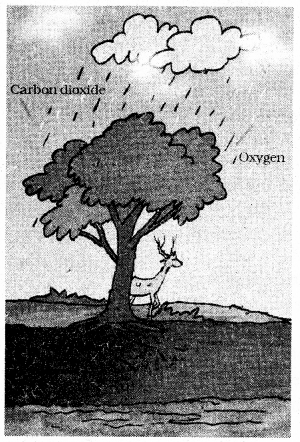
Question 11.
Which of the following is not a forest product?
Answer:
(i) Gum
(ii) Plywood
(iii) Sealing wax
(iv) Kerosene
Answer:
(iv) Kerosene
Question 12.
Which of the following statements is not correct?
(i) Forests protect the soil from erosion,
(ii) Plants and animals in a forest are not dependent on one another.
(iii) Forests influence the climate and water cycle.
(iv) Soil helps forests to grow and regenerate.
Answer:
(ii) Plants and animals in a forest are not dependent on one another.
Question 13.
Micro-organisms act upon the dead plants to produce
(i) sand
(ii) mushrooms
(iii) humus
(iv) wood
Answer:
(iii) humus
Class 7 Science Forests: Our Lifeline Additional Important Questions and Answers
Question 1.
Define the crown of the tree.
Answer:
The branchy part of a tree above the stem is known as the crown of the tree.
Question 2.
What is a canopy?
Answer:
The branches of the tall trees look like a roof over the other plants in the forest is called a canopy.
Question 3.
Which are the animals lived in the deeper areas of the forest?
Answer:
Boar, bison, Jackals, procupine, elephants live in the deeper areas of the forest.
Question 4.
Name some tress of the forest.
Answer:
Sal, teak, semal, shesham, neem, palash, fig, khair, amla, bamboo, kachnar etc.
Question 5.
Define understoreys, explain them.
Answer:
The trees in the forest had crown of different types and sizes. These had created different horizontal layers known as understoreys. Giant and tall trees constituted the top layer followed by shrubs and tall grasses and herbs formed the lowest layer.
Question 6.
Define a food Chain with an example.
Answer:
The process of food transfer from plants through a series of organisms. The chain of eating and being eaten is known as a food chain, for eg :
grass ➝ insects ➝ frog ➝ snake ➝ eagle
Question 7.
What are decomposers?
Answer:
The microorganisms which convert the dead plants and animals to humus are known as decomposers.
Question 8.
Draw a neat diagram of some crown shapes of trees.
Answer:

Question 9.
Draw a neat diagram and label the canopy and under stories in a forest.
Answer:
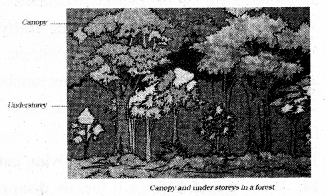
Question 10.
Draw a neat diagram and label the Interrelationship of plant, soil, and decomposers in a forest.
Answer:
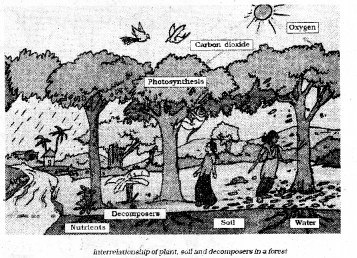
Question 11.
Draw a neat diagram and Label the rainwater drips from the trees and seeps into the ground.
Answer:
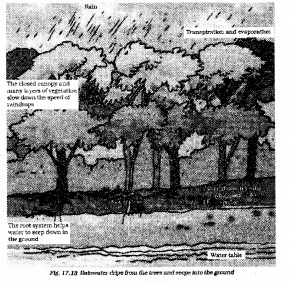
Question 12.
Why forests are called as ‘green lungs’
Answer:
All the green plants absorb Carbon dioxide for photosynthesis and release oxygen to the atmosphere. Thus they help to maintain the balance in Oxygen and Carboxdioxide level in the air (atmosphere) so the forests are called green lungs.
Question 13.
The forest is a ‘dynamic living entity’ explain.
Answer:
The forests harboring a greater variety of plants. It provides greater opportunities for food and habitat for the herbivores. A larger number of herbivores means increased availability of food for a variety of carnivores. The wide variety of animals helps the forest to regenerate and grow. Decomposers help in maintaining the supply of nutrients to the growing plants in the forest. Therefore the forest is a dynamic living entity. That means full of life and vitality.
Question 14.
What would happen if forests disappear?
Answer:
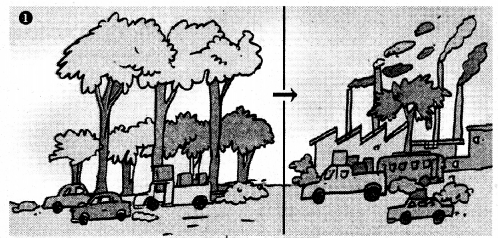
(1) If forests disappear, the amount of carbon dioxide in air will increase, resulting in an increase in earth’s temperature.
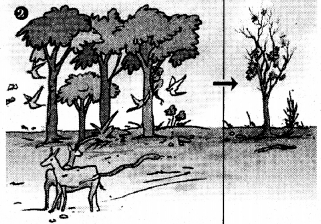
(2) In the absence of trees and plants, the animals will not get food and shelter.
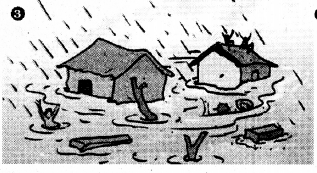
(3) In the absence of trees, the soil will not hold water, which will cause floods
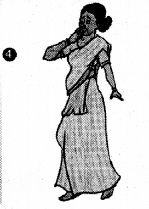
(4) Deforestation will endanger out life and environment Think, what we can do to preserve our forests.